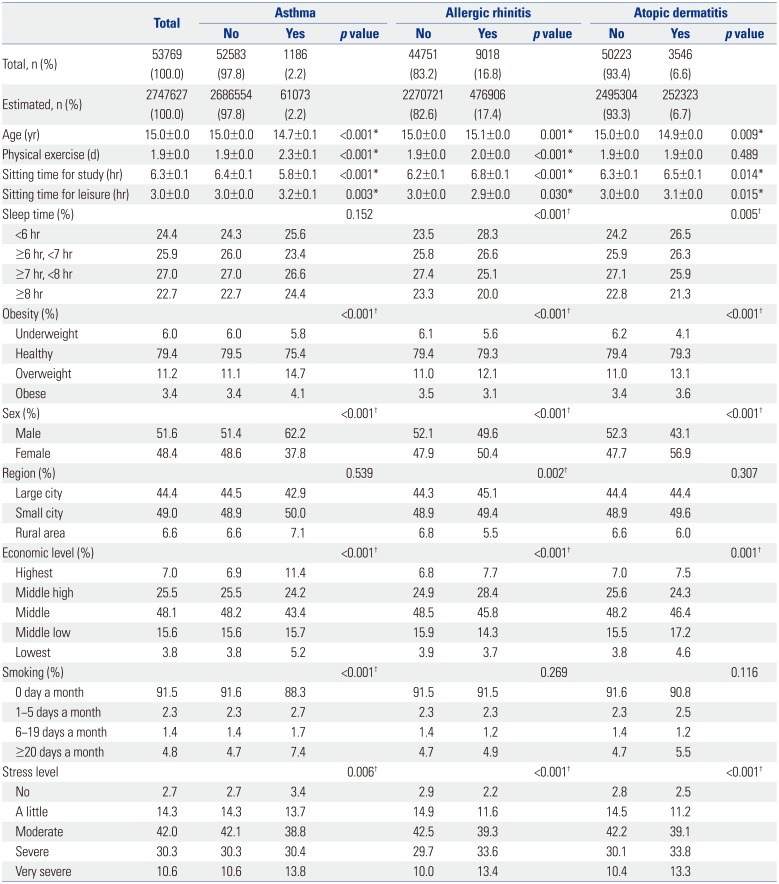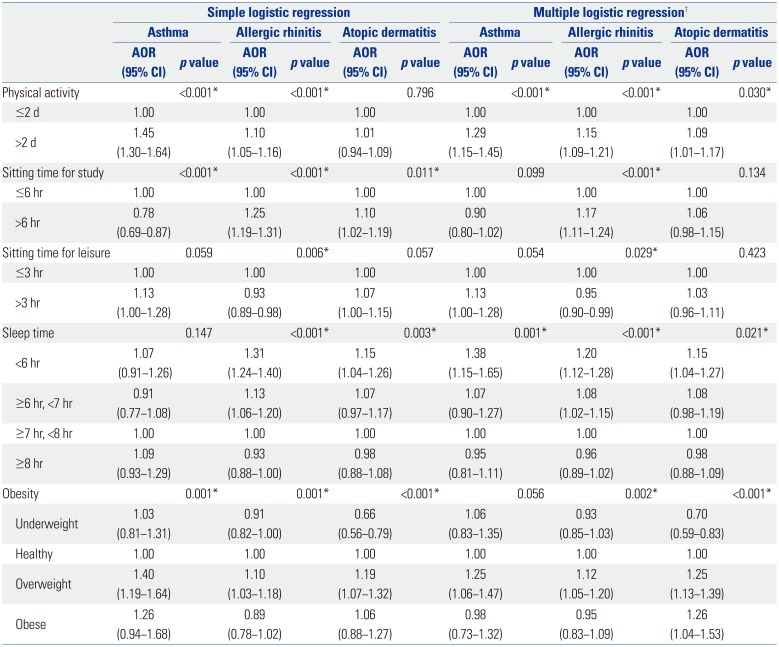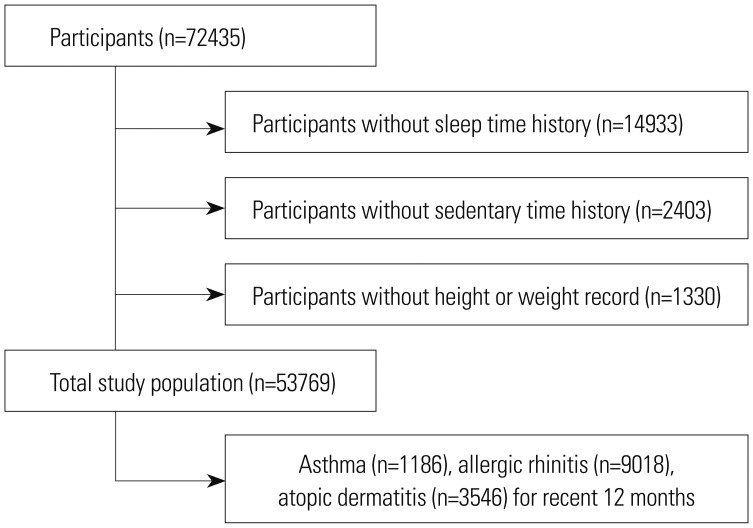1. Chen YC, Dong GH, Lin KC, Lee YL. Gender difference of childhood overweight and obesity in predicting the risk of incident asthma: a systematic review and meta-analysis. Obes Rev. 2013; 14:222–231. PMID:
23145849.

2. Tsai HJ, Tsai AC, Nriagu J, Ghosh D, Gong M, Sandretto A. Associations of BMI, TV-watching time, and physical activity on respiratory symptoms and asthma in 5th grade schoolchildren in Taipei, Taiwan. J Asthma. 2007; 44:397–401. PMID:
17613637.

3. Chen Y, Dales R, Tang M, Krewski D. Obesity may increase the incidence of asthma in women but not in men: longitudinal observations from the Canadian National Population Health Surveys. Am J Epidemiol. 2002; 155:191–197. PMID:
11821241.

4. Kim KM, Kim SS, Kwon JW, Jung JW, Kim TW, Lee SH, et al. Association between subcutaneous abdominal fat and airway hyperresponsiveness. Allergy Asthma Proc. 2011; 32:68–73. PMID:
21262101.

5. Parsons TJ, Manor O, Power C. Television viewing and obesity: a prospective study in the 1958 British birth cohort. Eur J Clin Nutr. 2008; 62:1355–1363. PMID:
17717536.

6. Staiano AE, Harrington DM, Barreira TV, Katzmarzyk PT. Sitting time and cardiometabolic risk in US adults: associations by sex, race, socioeconomic status and activity level. Br J Sports Med. 2014; 48:213–219. PMID:
23981954.

7. Guallar-Castillón P, Bayán-Bravo A, León-Muñoz LM, Balboa-Castillo T, López-García E, Gutierrez-Fisac JL, et al. The association of major patterns of physical activity, sedentary behavior and sleep with health-related quality of life: a cohort study. Prev Med. 2014; 67:248–254. PMID:
25138382.

8. Janssen I, Leblanc AG. Systematic review of the health benefits of physical activity and fitness in school-aged children and youth. Int J Behav Nutr Phys Act. 2010; 7:40. PMID:
20459784.

9. Kesaniemi YK, Danforth E Jr, Jensen MD, Kopelman PG, Lefèbvre P, Reeder BA. Dose-response issues concerning physical activity and health: an evidence-based symposium. Med Sci Sports Exerc. 2001; 33(6 Suppl):S351–S358. PMID:
11427759.
10. Cappuccio FP, Taggart FM, Kandala NB, Currie A, Peile E, Stranges S, et al. Meta-analysis of short sleep duration and obesity in children and adults. Sleep. 2008; 31:619–626. PMID:
18517032.

11. Knutson KL, Turek FW. The U-shaped association between sleep and health: the 2 peaks do not mean the same thing. Sleep. 2006; 29:878–879. PMID:
16895253.

12. Sybilski AJ, Raciborski F, Lipiec A, Tomaszewska A, Lusawa A, Furman´czyk K, et al. Obesity--a risk factor for asthma, but not for atopic dermatitis, allergic rhinitis and sensitization. Public Health Nutr. 2015; 18:530–536. PMID:
24739266.
13. Mitchell EA, Beasley R, Björkstén B, Crane J, García-Marcos L, Keil U. ISAAC Phase Three Study Group. The association between BMI, vigorous physical activity and television viewing and the risk of symptoms of asthma, rhinoconjunctivitis and eczema in children and adolescents: ISAAC Phase Three. Clin Exp Allergy. 2013; 43:73–84. PMID:
23278882.

14. Tanaka K, Miyake Y, Arakawa M, Sasaki S, Ohya Y. U-shaped association between body mass index and the prevalence of wheeze and asthma, but not eczema or rhinoconjunctivitis: the ryukyus child health study. J Asthma. 2011; 48:804–810. PMID:
21879808.

15. Sidell D, Shapiro NL, Bhattacharyya N. Obesity and the risk of chronic rhinosinusitis, allergic rhinitis, and acute otitis media in school-age children. Laryngoscope. 2013; 123:2360–2363. PMID:
23918707.

16. Zhang A, Silverberg JI. Association of atopic dermatitis with being overweight and obese: a systematic review and metaanalysis. J Am Acad Dermatol. 2015; 72:606–616. PMID:
25773409.

17. Bae J, Joung H, Kim JY, Kwon KN, Kim Y, Park SW. Validity of self-reported height, weight, and body mass index of the Korea Youth Risk Behavior Web-Based Survey questionnaire. J Prev Med Public Health. 2010; 43:396–402. PMID:
20959710.

18. Bae J, Joung H, Kim JY, Kwon KN, Kim YT, Park SW. Test-retest reliability of a questionnaire for the Korea Youth Risk Behavior Web-Based Survey. J Prev Med Public Health. 2010; 43:403–410. PMID:
20959711.

20. Randolph C. Exercise-induced asthma: update on pathophysiology, clinical diagnosis, and treatment. Curr Probl Pediatr. 1997; 27:53–77. PMID:
9059761.

21. Pianosi PT, Davis HS. Determinants of physical fitness in children with asthma. Pediatrics. 2004; 113(3 Pt 1):e225–e229. PMID:
14993581.

22. Fitch KD, Blitvich JD, Morton AR. The effect of running training on exercise-induced asthma. Ann Allergy. 1986; 57:90–94. PMID:
3740562.
23. Firrincieli V, Keller A, Ehrensberger R, Platts-Mills J, Shufflebarger C, Geldmaker B, et al. Decreased physical activity among Head Start children with a history of wheezing: use of an accelerometer to measure activity. Pediatr Pulmonol. 2005; 40:57–63. PMID:
15858799.
24. Rasmussen F, Lambrechtsen J, Siersted HC, Hansen HS, Hansen NC. Low physical fitness in childhood is associated with the development of asthma in young adulthood: the Odense schoolchild study. Eur Respir J. 2000; 16:866–870. PMID:
11153585.

25. Ownby DR, Peterson EL, Nelson D, Joseph CC, Williams LK, Johnson CC. The relationship of physical activity and percentage of body fat to the risk of asthma in 8- to 10-year-old children. J Asthma. 2007; 44:885–889. PMID:
18097868.

26. Jones SE, Merkle SL, Fulton JE, Wheeler LS, Mannino DM. Relationship between asthma, overweight, and physical activity among U.S. high school students. J Community Health. 2006; 31:469–478. PMID:
17186641.

27. Rundle A, Goldstein IF, Mellins RB, Ashby-Thompson M, Hoepner L, Jacobson JS. Physical activity and asthma symptoms among New York City Head Start Children. J Asthma. 2009; 46:803–809. PMID:
19863284.

28. Kim JW, So WY, Kim YS. Association between asthma and physical activity in Korean adolescents: the 3rd Korea Youth Risk Behavior Web-based Survey (KYRBWS-III). Eur J Public Health. 2012; 22:864–868. PMID:
22158994.
29. Kim A, Silverberg JI. A systematic review of vigorous physical activity in eczema. Br J Dermatol. 2016; 174:660–662. PMID:
26385020.

30. Kikuchi H, Inoue S, Sugiyama T, Owen N, Oka K, Nakaya T, et al. Distinct associations of different sedentary behaviors with health-related attributes among older adults. Prev Med. 2014; 67:335–339. PMID:
25117527.

31. Lang JE. Obesity and asthma in children: current and future therapeutic options. Paediatr Drugs. 2014; 16:179–188. PMID:
24604125.

32. Koinis-Mitchell D, Kopel SJ, Boergers J, Ramos K, LeBourgeois M, McQuaid EL, et al. Asthma, allergic rhinitis, and sleep problems in urban children. J Clin Sleep Med. 2015; 11:101–110. PMID:
25515273.

33. Turner-Warwick M. Epidemiology of nocturnal asthma. Am J Med. 1988; 85:6–8.

34. Craig TJ, McCann JL, Gurevich F, Davies MJ. The correlation between allergic rhinitis and sleep disturbance. J Allergy Clin Immunol. 2004; 114(5 Suppl):S139–S145. PMID:
15536445.

35. Reuveni H, Chapnick G, Tal A, Tarasiuk A. Sleep fragmentation in children with atopic dermatitis. Arch Pediatr Adolesc Med. 1999; 153:249–253. PMID:
10086401.

36. Esteitie R, Emani J, Sharma S, Suskind DL, Baroody FM. Effect of fluticasone furoate on interleukin 6 secretion from adenoid tissues in children with obstructive sleep apnea. Arch Otolaryngol Head Neck Surg. 2011; 137:576–582. PMID:
21690510.







 PDF
PDF ePub
ePub Citation
Citation Print
Print



 XML Download
XML Download